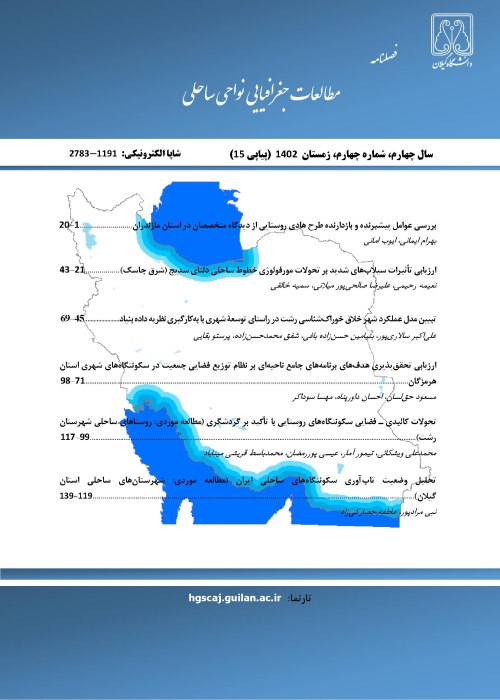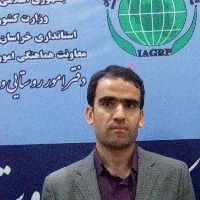Identifying and Analyzing the Challenges Facing the Development of Tourism in the Sea of Oman (Case Study: Sistān and Baluchestān Province)
This study aimed to identify and analyze the barriers to tourism development on the coasts of the Oman Sea. It was descriptive-analytical research. A researcher-made questionnaire was used to collect data. The research population included two categories: the incoming tourists to the region, from which 382 questionnaires were randomly selected using Cochran's formula from among the available and responsive tourists, and 30 officials of departments related to tourism. A one-way t-test, multivariate regression analysis, and path analysis were used to analyze the research findings. The results of the one-sample t-test showed that in terms of tourists, tourism on the Oman Sea coast is unfavorable. The average economic barriers (2.920), advertising barriers (2.957), infrastructure and service barriers (2.912), beach sports barriers (2.767), socio-cultural barriers (2.928), and Management barriers (2.857) were all below the desired average (3). The results of linear regression analysis showed that the managerial barriers and economic barriers with beta values of 0.368 and 0.302, respectively, had the most impact and barriers to doing water sports with a beta coefficient of 0.154, social barriers with a beta coefficient of 0.171 barriers to infrastructure facilities and tourism services with a beta coefficient of 0.224 and advertising barriers with a beta coefficient of 0.294, respectively, had less impact on the coastal tourism on the coast of the Oman Sea. Also, the results of route analysis showed that managerial barriers with 0.820 and economic barriers with 0.623 had the most significant impact on the coastal tourism of the Oman Sea, respectively, and the beach sports barriers with 0.154 had the least impact on tourism. Therefore, according to the obtained results, it can be said that the barriers to the development of tourism on the coasts of the Oman Sea depend on factors such as economic, propaganda, management, socio-cultural factors, beach sports, and infrastructure - services. As long as these problems and barriers are not removed, tourism in these areas will not reach proper growth and development.Extended Abstract Introduction Activities on the shores and areas surrounding the seas, such as sunbathing, swimming, boat riding, wave surfing, water skiing, flying in the air, diving, fishing sports, and other water recreational activities, are the main attractions in many parts of the world. Today tourism primarily develops adjacent to the seas, and beach tourism counts among the most significant economic development and job creation models. Tourists travel to coastal regions to visit the shores and use the coastal facilities. Enjoying the benefits of tourism requires removing all the hurdles and challenges facing this activity, such as the lack of management skills, poor marketing, lack or shortage of tourist services, seasonal limitations, and regulation void. To this aim, actions, including building and developing the infrastructures, sustainable advertisement, and marketing, responsible holding of tourist tours, setting the stage for private and non-public investment in beach tourism, prioritizing the demands and goals of locals to satisfy their needs, and designing appropriate laws and regulations. MethodologyThis research is applied in terms of objective. It draws on a descriptive and analytical methodology and utilizes the library method and fieldwork to gather data. Questionnaires are used in the fieldwork. The statistical population of the research consists of incoming tourists to the region (Konārak and Chābahār shores) and the authorities in charge of beach tourism. According to data released by the Ministry of Heritage, Culture, Tourism, and Handicraft, tourists visiting the Sistān and Baluchestān province shores reached over 100 thousand in 2019. Using the Cochran formula, 382 questionnaires were completed by availability sampling from among the tourists visiting the Sistān and Baluchestān province shores. Thirty officials from the office in charge of tourism in Konārak and Chābahār towns were chosen as the second statistical research population. SPSS and EXCEl software packages were employed to analyze data. One-sample t-test, linear regression analysis, path analysis, and factor analysis were used to analyze data. Opinions of 5 university professors and experts were elicited to examine the questionnaire validity, which was confirmed after investigation and revision. The questionnaire reliability was calculated using alpha Cronbach 0.81. Kolmogorov-Smirnov test confirmed a normal distribution of the data. After conducting fieldwork and interviewing local experts, the challenges facing tourism development on the shores of the Sea of Oman were identified and categorized into six groups: Cultural-social, economic, infrastructural, tourism services, management, advertisement, and beach sports.Results and discussionFindings suggest that 138 respondents (36 percent) are female, and 244 (64 percent) are male. Other findings are as follows. Challenges to beach tourism development are cultural and social obstacles, economic hurdles, infrastructural facilities, tourism services, management hurdles, challenges facing the development of beach sports, and advertisement challenges. Given the data's Normal distribution, the one-sample t-test and parametric tests were employed to investigate the obstacles to the development of beach tourism on the shores of the Sea of Oman.ConclusionFindings indicate that the development of beach tourism faces numerous challenges in these regions. These challenges include social-cultural challenges like the lack of familiarity of the locals with the role and significance of tourism in development, lack of complete knowledge on how to treat the tourists, fear of insecurity among the tourists, lack of tourism police in the region, lack of a culture of using tourism resources, and facilities; economic challenges like the tourists' propensity to neighboring rival regions, lack of governmental insurance and financial support of the existing investors, Unwillingness of the native and non-native investors to invest in tourism, local's lack of access to more financial resources, inflation, foreign exchange fluctuations in the country, tourism services, and infrastructural challenges, such as welfare facilities in the tourism sites, and the low quality of tourism services Management hurdles like inattention of authorities to the significance of beach tourism, lack of expert and skilled forces in tourism institutions and bodies, lack of cooperation among organizations in charge of tourism to develop beach tourism, planning and decision-making weakness regarding tourism and beach tourism, neglecting the task of spreading information regarding tourism on the part of tourism authorities, lack of suitable, early-yielding tourism plan to encourage investors in beach tourism, and the lack of sufficient skills on the part of tourism officials in the region to plan tourism development Beach sports challenges like a lack of boat riding tournaments, beach soccer, wave surfing, open water swimming tournaments, international beach sports tournaments, lack of investment in beach sports, neglect of the high potential of beach sports to attract tourists, lack of high skills on the part of tourism officials in the region to plan tourism development, lack of necessary facilities for beach sports Advertisement challenges like lack of radio advertisements on the province's beach tourism, negligence on the part of information-broadcasting institutions such as the Islamic Republic of Iran Broadcasting in changing the perceptions of the country's tourists toward the province and its shores, a multitude of documentaries and films depicting the area as unsafe, and media exaggeration of the adverse events in the region (insecurity).FundingThere is no funding support.Authors’ Contribution Authors contributed equally to the conceptualization and writing of the article. All of the authors approved the content of the manuscript and agreed on all aspects of the workConflict of InterestAuthors declared no conflict of interest.Acknowledgments We are grateful to all the persons for scientific consulting in this paper.
- حق عضویت دریافتی صرف حمایت از نشریات عضو و نگهداری، تکمیل و توسعه مگیران میشود.
- پرداخت حق اشتراک و دانلود مقالات اجازه بازنشر آن در سایر رسانههای چاپی و دیجیتال را به کاربر نمیدهد.




